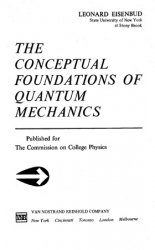
Автор: Eisenbud Leonard
Название: The Conceptual Foundations of Quantum Mechanics
Издательство: Van Nostrand Reinhold
Год: 1971
ISBN: 9781131311982
Язык: English
Формат: pdf
Размер: 13,9 mb
Страниц: 148
There are two complementary methods, broadly speaking, used by authors to communicate physics. In the first of these, the “formal method,” the manipulatory skills relating to the subject matter of interest are emphasized. It is tacitly assumed that a mastery of the techniques required to solve the standard problems will lead automatically and rapidly to an understanding of the physical meanings of the techniques and their products. In the second, the “conceptual method,” physical meanings are investigated carefully with little attention to technique. Once the basic concepts are clearly understood, or so it is assumed, manipulative skills will take care of themselves. Graduates of the formal method calculate easily (at least on textbook problems) but often they know not what they compute. The conceptual method, on the other hand, produces philosophical wranglers who can tear subtle ideas to shreds but who are unable, perhaps, to draw a fresh conclusion from even the most fruitful stock of ideas.
To whom and for what, then, is the book of value? Two distinct groups may profit from it. Students who have been exposed to highly formal expositions and are only too painfully aware that they know not what they compute may find answers to some of their questions in the following pages. And those blocked from the normal paths which lead to the quantum mechanics by lack of mathematical skills may be able to get here at least a partial understanding of some of the significant ideas of a most important and fascinating theory.
Preface vii
1 THE FAILURE OF CLASSICAL THEORY 1
2 CONSEQUENCES OF A MISTRUST OF THEORY 6
3 PROPERTIES OF ELECTRONS, PHOTONS; THE DE BROGLIE RELATIONS 12
3.1 The de Broglie Relations 14
4 AN ANALYSIS OF ELECTRON DIFFRACTION 17
5 HEISENBERG’S PRINCIPLE OF INDETERMINACY 32
5.1 Supplement to Chapter 4 37
5.2 Continuation: Heisenberg’s Principle 39
6 INTERPRETATIONS OF THE HEISENBERG PRINCIPLE 42
6.1 Classical Statistics 42
6.2 Hidden Variables 45
6.3 A Nonclassical Interpretation of the Heisenberg Principle 47
7 DYNAMICAL PROPERTIES OF MICROSYSTEMS 57
7.1 Objective Properties 59
7.2 Measurement and Property 61
7.3 Incompatibility 69
7.4 Observables 73
7.5 Distributions 77
8 DETERMINISM AND STATE; STATISTICAL DETERMINISM 89
8.1 The Principle of Determinism and the Classical Concept of State 89
8.2 The Principle of Statistical Determinism 95
8.3 The Microphysical Concept of State 100
9 PROBABILITY AMPLITUDES; THE SUPERPOSITION PRINCIPLE 109
9.1 Introduction 109
9.2 The Interference of Electrons 110
9.3 Probability Amplitudes 113
9.4 State Representatives 119
9.3 Motions of Ensembles and States 123 9.6 The Motion of Free Electrons 126
10 SUMMARY AND COMMENT 130
10.1 Epitome 130
10.2 The Laws of Quantum Mechanics 135
10.3 Consequences of a Successful Theory of Microphysics 139
10.4 Critical Notes 140
10.5 Conceptual Revolutions in Physics 141
INDEX 145
|